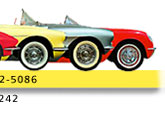




![]() New Arrivals
New Arrivals
1953-55
1956-57
1958-60
1961-62
1963-64
1965-66
1967
1968-72
1973-79
1980-82
1984-96
1997-10
Offer to
Purchase
Money Back
Guarantee
Sell Us
Your Corvette
Request a
Vette
Testimonials
Sold Cars
Site Index
Contact Us
Join ProTeam's
newsFlash list email:
|
**What has been written about the L-88 Corvette...
Racing improves the breed...
The Mark IV's development was a direct result of Chevrolet's search for more performance than the W-series could find within unusual canted-deck, flat bottom cylinder head design. The secret of the Mark IV was its heads that angled the valves in two planes to create a semi-hemispherical combustion chamber with gently-curved runners and efficient valve location. The ultimate development of the Mark IV big block was the L88 Corvette. Each engine was individually built, assembled, blueprinted and tested off-line in the Tonawanda engine factory.
The word on the L88 hardly got out in 1967 and only 20 were built. Awareness grew in 1968, when 80 were delivered, followed by 116 in 1969, the last year in production. The L88's reputation far exceeded its exposure and these 216 Corvettes have become the most sought and valuable of all Corvettes. Many were raced, gathering laurels in North America and in Europe. Others were raced less formally on side streets and service roads.
Only 80 L88 Corvettes were built in 1968; the same number of 1968 Corvettes came with the M22 close ratio, heavy duty 'Rock Crusher' transmission. Only 81 Corvettes with the J56 special performance brakes were built. PRO Export Preparation is so rare and unusual it doesn't appear on published options lists for 1968 Corvettes.
Modern Corvettes boast blazing performance in their Z06 packages but their performance pales in contrast with this brutal, exhilarating 1968 and 1969 L88.
Buyers who lived in the right place, got along well with their Chevy dealer and knew the right codes and terminology could tailor their Corvette exactly to their liking and with just a little edge over even owners of comparably-powered Corvettes. One example of a tiny but significant advantage was 'Export' cars which avoided some of the power-robbing and weight-adding emission control equipment. No car could better benefit from incremental improvements of export preparation than the L88 Corvette.
Built off-line in a corner of Chevrolet's Tonawanda, NY engine factory, the L88's attributes were legendary. It was Corvette's answer to the Cobras and Ferraris, a full-bore racing engine that appeared on paper to be sufficiently unattractive than all but the well-informed, serious racers would overlook it. The L88 option appeared on Corvette's option list as a 430hp version of the 427 cubic inch engine. In rating the L88, Chevy quit the dyno run well below the rpm where it had maximum torque, much less maximum horsepower. In actual fact every L88 cranked out 550 or so horsepower.
Every part was individually weighed, blueprinted, fitted. You didn't get air conditioning with the L88 engine. You could get your L88 without emissions control equipment by specifying PRO if the ordering dealer and any watchful order processor upstream let it through.
Racing improves breed, but the old time sensations are bigger, better and more exciting.
**SOURCE: Bonhams & Butterfields Auction Catalog, Quail Lodge Resort & Golf Club, Friday, August 17th, 2007
proteam@proteamcorvette.com - - page update: October 20, 2007
Click here to check out ProTeam's Corvette news archives dating back to January 2006










